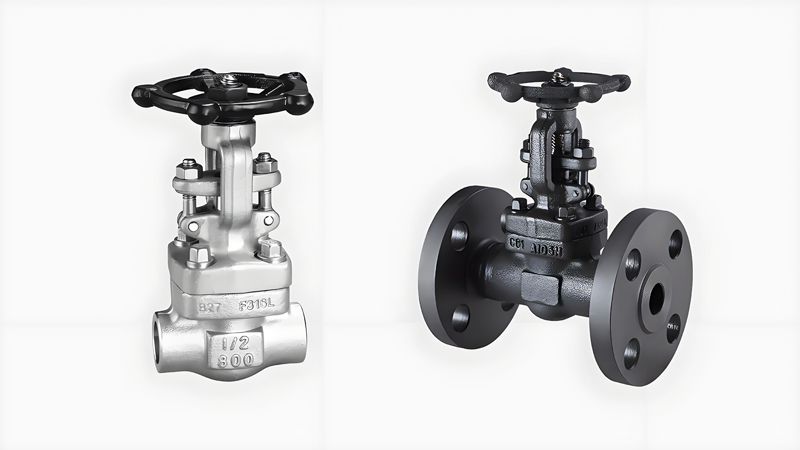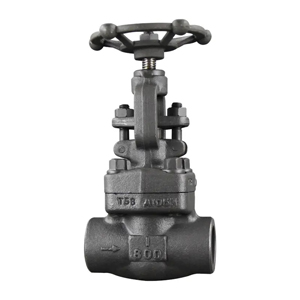The Ultimate Guide to Forged Globe Valves: Strength, Precision, and Reliability
In the critical world of fluid control, where pressure, temperature, and reliability are paramount, Forged Globe Valves stand out as the preferred choice for severe service conditions. Unlike their cast counterparts, these valves are meticulously crafted from solid metal billets subjected to intense heat and pressure (forging), resulting in a denser, stronger, and more reliable microstructure. This guide dives deep into forged steel globe valves and forged stainless steel globe valves, exploring their construction, function, standards, materials, and key specifications.

What is a Forged Globe Valve
A Forged Globe Valve is a type of linear motion valve primarily designed for throttling flow and providing positive shut-off in high-pressure and high-temperature piping systems. The defining characteristic is its manufacturing process: key components like the valve body and bonnet are formed through forging. This process aligns the grain flow of the metal, significantly enhancing its mechanical strength, impact resistance, and integrity compared to casting. Forged globe valves are synonymous with durability and leak prevention in critical applications across oil & gas, power generation, chemical processing, and refining.

Anatomy of Strength: Forged Globe Valve Structure
Understanding the robust structure is key to appreciating their performance:
1. Forged Body:
The core pressure-containing component, shaped by forging for superior density and strength. Features inlet and outlet ports and the internal flow path.
2. Forged Bonnet:
The forged cover bolted or threaded to the body, providing access to the internals and sealing the system pressure. Bonnet gaskets ensure a tight seal.
3. Disc (Plug):
The movable element that modulates or stops flow by seating against or lifting from the stationary seat ring. Often tapered or parabolic for precise throttling.
4. Seat Ring:
A hardened ring (often replaceable) installed in the body against which the disc seals to achieve shut-off.
5. Stem:
A precision-machined shaft that transmits the force from the actuator (handwheel, gear, etc.) to the disc. Connected via threads (rising stem design is common).
6. Yoke & Actuator Mounting:
The structure connecting the bonnet to the actuator (handwheel, gear operator, pneumatic/hydraulic actuator).
7. Packing Gland:
The assembly compressing packing material around the stem to prevent leakage along the stem path while allowing movement.
Core Function: Precision Flow Control and Shut-off
The primary functions of a forged globe valve are:
1. Throttling Control:
The design allows for precise modulation of flow rate. The disc’s linear movement relative to the seat enables fine adjustments, making it excellent for regulating flow.
2. Positive Shut-off:
When fully closed, the disc seats firmly against the seat ring, creating a bubble-tight seal capable of handling high pressures. This is critical for isolation and safety.
3. Flow Direction:
Globe valves have a distinct flow direction (indicated by an arrow on the body). Flow typically enters below the seat and exits above it, ensuring proper sealing and seat loading when closed. Reversing flow can cause premature wear or leakage.
Standards Governing Forged Globe Valves (API 602)
Quality and interchangeability are ensured by stringent standards. The most prominent is:
* API 602:
This American Petroleum Institute standard, titled “Compact Design Gate, Globe, and Check Valves for Refinery Use,” is the definitive specification for **forged steel globe valves**, gate valves, and check valves 2 inches (DN 50) and smaller. It covers design, materials, testing, inspection, and pressure-temperature ratings for **API 602 Forge Globe Valves**. Compliance with API 602 signifies high integrity for critical hydrocarbon service.
* ASME B16.34:
This standard defines pressure-temperature ratings, materials, dimensions, tolerances, marking, and testing requirements for valves of all sizes, including larger forged globe valves. It establishes the foundation for pressure classes (e.g., Class 800).
* Other Standards:
MSS SP-42 (Corrosion Resistant Valves), MSS SP-80 (Bronze Gate, Globe, Angle & Check Valves – though primarily bronze), BS 5352 (UK equivalent to API 602), and various ISO standards may also apply depending on region and application.
Material Matters: Construction of Forged Globe Valves
The forging process utilizes high-quality materials suitable for demanding environments:
* Carbon Steel (ASTM A105):
The most common material for general high-pressure/temperature service. Offers excellent strength and value. A105 forged steel globe valves are widely used in steam, oil, and gas.
* Low-Temp Carbon Steel (ASTM A350 LF2/LF3):
Used for sub-zero temperature applications to prevent brittle fracture.
* Alloy Steels (ASTM A182 F11, F22, F91):
Provide enhanced strength and corrosion resistance at elevated temperatures (e.g., power plants).
* Stainless Steels (ASTM A182 F304/F304L, F316/F316L, F347):
Essential for corrosion resistance in chemical, petrochemical, marine, and food-grade applications. Forged stainless steel globe valves offer durability against a wide range of aggressive media.
* Duplex/Super Duplex Stainless Steels (ASTM A182 F51, F53, F55):
For exceptional strength and corrosion resistance in highly corrosive environments (e.g., offshore, chlorides).
* Nickel Alloys (Alloy 400, 600, 625, C276):
For the most severe corrosive and high-temperature services.
Handling the Pressure: Pressure Range and Class Ratings
Forged globe valves are specifically engineered for high-pressure service:
* Pressure Class:
Primarily conform to ASME B16.34 pressure classes. Common classes include 800, 1500, and 2500.
* Class 800 Dominance:
Forged steel globe valve class 800 is arguably the most prevalent standard rating for high-pressure applications in the 2″ and smaller sizes governed by API 602. It signifies suitability for pressures up to 1380 psig (95 bar) at 100°F (38°C), with ratings decreasing as temperature increases (per ASME B16.34 tables).
* Higher Classes:
Class 1500 (2500 psig @ 100°F) and Class 2500 (4500 psig @ 100°F) are used for even more extreme pressures. **Forged globe valves** excel in these ranges due to their inherent strength.
* Example:
A 1 2 800 forged steel threaded globe valve refers to a 1/2 inch size, Class 800 pressure rating, carbon steel (typically A105) valve with threaded ends.
Ensuring Fit: Dimensions of Forged Globe Valves
Dimensions are standardized for interchangeability:
* API 602 Compact Design:
Valves built to API 602 have specific face-to-face dimensions, significantly shorter than standard ASME B16.10 dimensions for equivalent cast valves. This “compact” design saves space and weight.
* End Connections:
Common options include:
* Threaded (NPT, BSPT, BSPP) – Common for smaller sizes like the 1 2 800 forged steel threaded globe valve.
* Socket Weld (SW) – Popular for high-integrity small bore piping.
* Butt Weld (BW) – Used for the highest integrity, permanent installations. Requires beveled ends per ASME B16.25.
* Flanged (Less common for small forged valves; ASME B16.5 dimensions apply).
* Key Dimensions:
Face-to-face (F2F), end-to-end (for flanged), center-to-face (for angle pattern valves), stem rise (for rising stem), handwheel diameter, and bolt circle/bore for flanged bonnets. Always refer to manufacturer’s dimensional drawings for specific models.
Finding Quality: Forged Globe Valve Manufacturers and Suppliers
Choosing a reliable source is critical for performance and safety
* Reputable Forged Globe Valve Manufacturers:
Look for established manufacturers with:
* API 602 Monogram License (crucial for oil & gas).
* ISO 9001 Quality Management certification.
* Extensive material traceability and testing (e.g., PMI, NDE, hydrostatic testing).
* Proven experience in your industry.
* Trusted Forged Globe Valve Suppliers:
Distributors and forged globe valve suppliers play a vital role. Select partners who:
* Source from reputable, certified forged globe valve manufacturers.
* Offer technical expertise and application support.
* Maintain comprehensive inventory for common sizes/materials (e.g., A105 forged steel globe valve, forged stainless steel globe valves).
* Provide reliable logistics and after-sales support.
* Can source specialized valves (e.g., forged steel globe valve class 800 in exotic materials).
Conclusion: The Indispensable Forged Solution
When failure is not an option under high pressure, temperature, or in corrosive environments, forged globe valves deliver unmatched reliability and longevity. Their superior forged construction, adherence to strict standards like API 602, precise flow control capability, and availability in robust materials like A105 carbon steel and stainless steel make them the cornerstone of critical industrial fluid systems. Whether you need a standard 1 2 800 forged steel threaded globe valve or a specialized alloy solution, partnering with qualified forged globe valve manufacturers and forged globe valve suppliers ensures you get the performance and safety your application demands.
Post time: May-30-2025






